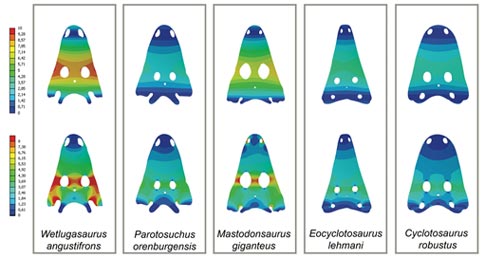Ancient Amphibians Possessed Bites as Strong as a Crocodiles
Research suggest that Capitosaurs were the “Crocodiles” of the Permian and the Triassic
Long before the reptilian ancestors of crocodiles evolved, ancient lakes and swamps had there own set of aquatic ambush predators – amphibians, members of a group known as the Temnospondyls. Fossils of ancient amphibians have been found world-wide and it is believed these animals evolved in the Carboniferous, evolving into a myriad of terrestrial and aquatic predators.
Ancient Amphibians
A study by researchers at the Catalan Institute of Palaeontology in association with their colleagues at the University of Catalonia has assessed the bite force capabilities of number of these animals and challenged a hypothesis regarding the strength of these animal’s bites that had been put forward more than forty years ago. It seems that both basal and more advanced forms of Temnospondyls were capable of biting down onto prey with considerable force. In contrast to the earlier theory, that postulated that the shape and size of the bones that supported the muscles were responsible for generating a strong bite force, it seems that muzzle shape and dimensions are more significant when it comes to assessing how strong a bite force one of these predators could generate.
Temnospondyls were a large and diverse group of amphibians with stout limbs, strong bodies and big, wide mouths. Some of these creatures could grow to lengths in excess of three metres and many of them occupied environmental niches similar to modern-day crocodiles.
An Illustration of a Typical Aquatic Predator (Temnospondyl)
Picture credit: Mauricio Anton (Catalan Institute of Palaeontology)
Temnospondyls
It had been thought that the last of the Temnospondyls died out at the end of the Triassic but Australian fossils suggest that some of these amphibians survived into the Jurassic and into the Early Cretaceous, living in parts of the world that were too cold for the crocodylomorphs to survive in. The study focused on members of the capitosaur taxon, advanced active, predatory members of the Temnospondyls. Seventeen taxa were studied and the research suggests that many of these animals could generate bite forces similar to those of modern crocodiles.
Extant species of amphibian such as the salamanders, although they possess wide mouths, do not have strong bites. They suck prey items into their mouths. This research suggests that at least some of the capitosaurs had masticatory capabilities similar to crocodylians, an article detailing the research has been published in the scientific journal “The Anatomical Record”.
Josep Fortuny (Catalan Institute of Palaeontology), along with colleagues has shown that changes to the shape of these animal’s skulls influenced the way that they fed. These large, carnivores had a wide range of different bite strengths.
The Catalan-based researchers studied the evolution of different morphological features in the capitosaurs’ skulls using computer models and careful scans of the actual fossil material to determine the stress distribution across the skull bones for different types of bite.
Commenting on their research, Josep stated:
“Apart from explaining how capitosaurs fed, we also wanted to validate the theory by palaeontologist A. Howie from the 1970s, and here are results were somewhat surprising.”
Primitive capitosaurs had posteriorly directed tabular horns, (bony struts associated with the back of the skull that pointed rearwards), these are the bones that anchor the muscles responsible for opening and closing the mouth. In more derived, advanced forms, however, they moved laterally to create a small island in the back of the skull, known as the otic notch. Howie argued that this evolution facilitated a more optimal bite, at the biomechanical level. However, the Spanish research refutes this demonstrating that the most primitive tabular horns were also optimal for the opening of the mouth. Therefore, the evolutionary mechanisms that led to the closure of the otic notch do not have much to do with improved biomechanics of this movement, but the scientists state that more studies are needed to better understand these morphological changes.
Illustration of Capitsosaur Skull Types
Picture credit: Catalan Institute of Palaeontology
In the images of these two capitosaur skulls shown above, Parotosuchus left and Eocyclotosaurus right, tabular horns (A) and the Otic Notch (B) are observed.
In its most basal, primitive forms, as is the case of Wetlugasaurus, skulls are weaker. As forms radiate, capitosaurs seem better able to generate a more powerful bite, perhaps in response to the evolution of their prey and increased competition from the rapidly evolving reptiles.
Computer Generated Images Indicate Bite Strengths of Various Capitosaurs
In the images deformations (top) and stresses (bottom) are observed from simulations of a bilateral bite for several capitosaur species. The more primitive, basal form such as Wetlugasaurus (far left) had a weak bite, but Parotosuchus with its large tabulate horns had a powerful bite, challenging the theory first put forward by Howie.
The elongation of the tabular horns, with the consequent closure of the otic notch, was taken for years as an indicator of a more powerful bite. This study shows, however, that Paratosuchus had one of the most powerful bites of the study group, along with Cyclotosaurus, although the otic notch is open and the tabular horns are not particularly long. From the computer generated data, it seems that other factors such as the width of the skull and the snout length are equally or perhaps more important factors in generating bite force as opposed to the tabular horns or the otic notch closure.
This research suggests that these predators evolved to take advantage of a number of ecological niches as land vertebrate food chains became more complex.
For not-to-scale models of prehistoric animals including ancient amphibians (whilst stocks last): Models of Permian and Triassic Animals (CollectA).




